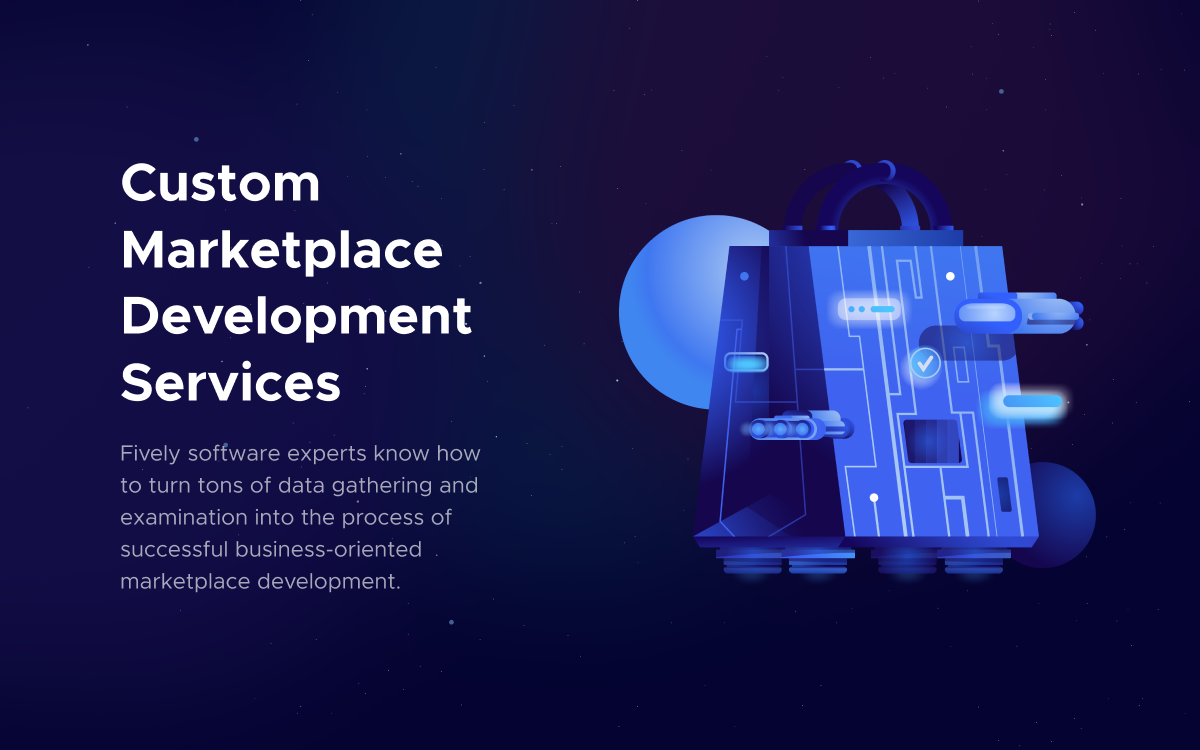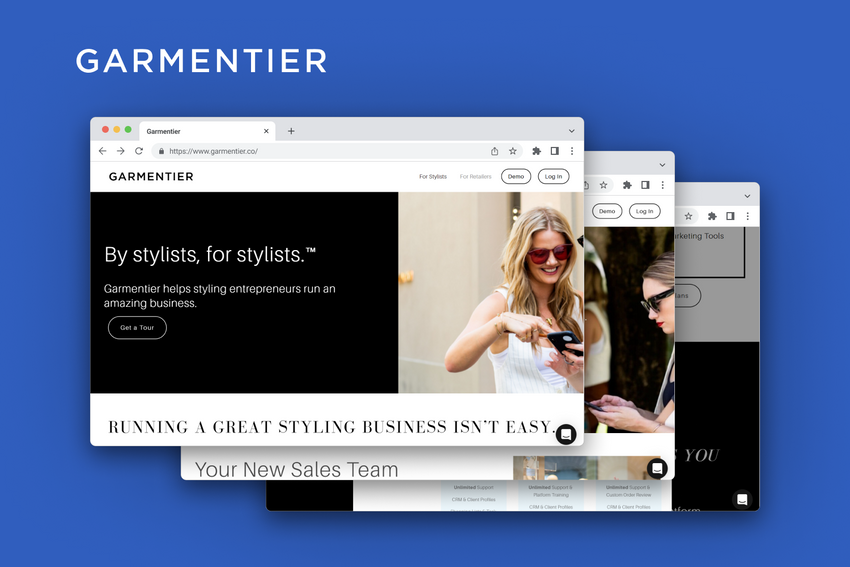How to Build a B2B MarketPlace
Read our definitive guide to find out how to create a marketplace from scratch.
Business to business eCommerce is on the rise these days: transactions are growing and predicted to reach $3 trillion by 2027 (Forrester). It looks like the coming years will be a high time for marketplace development. Do you think so too? Then our article is for you. We have collected the industry trends and challenges, some estimates, and also best practices from our experience of making a business to business marketplace.
What Is a B2B Marketplace Solution? We Explain in Simple Words
Let’s start our guide with some important definitions.
Business-to-business (B2B) operations are exchanges between companies. These companies can sell or buy relevant products, services, information, etc. In simple words: one business purchases from another.
Business-to-consumer (B2C) operations are the opposite of what B2B buyers and sellers do. If we put it simply: a person purchases from a company.
What is a B2B marketplace, then? It is a sophisticated website created for one purpose: to provide seamless communication between buyers and sellers.
We can say from experience that business-to-business marketplace development is quite similar to making other types of eCommerce platforms. However, there are some critical differences that you should know about.
Online B2B marketplace vs B2C marketplace:
- Order value: it is huge in B2B and much smaller in B2C.
- Payments: specific types of transactions in B2B (wire transfers, paper checks, bank transfers) that require special payment gateways.
- User experience: there are more people involved in order management on B2B marketplaces, and the development team works thoroughly on collaboration tools and user-friendly interfaces.
One more unique quality of a business-to-business marketplace is the classification: there are four types of such websites. Let’s find out more about them.
4 Types of B2B Marketplace Solutions
The conversation about building a marketplace makes no sense without learning about types of web portals for B2B buying and selling. What companies sell (and buy) is the primary point of classification.
Alibaba is a product-based B2B marketplace, which means businesses sell and buy physical goods there.

Fiverr is a service-based online platform, meaning that companies purchase services with it.

Amazon Business is a classical example of a horizontal B2B marketplace: it works across different industries and allows to sell a wide selection of goods and services.

Toursworld is a vertical B2B marketplace working for a specific target audience – the travel industry businesses. The main thing about all vertical B2B marketplaces is that they go deeper and choose a certain niche to focus on.
It is worth being aware about these four types if you plan to build your own B2B marketplace platform. Once you have decided how you see your website’s goal and audience, it becomes much easier to choose features and design.
However, marketplace development is associated with specific challenges. Let’s talk about the main reasons why some platforms never come to success.
Why Do B2B Marketplaces Fail?
B2B sales bring certain challenges that you may never face in the B2C sector. The reason why some B2B marketplace startups fail is because their teams struggle to foresee the risks and evaluate them correctly.
We will describe some challenges and offer possible solutions.
A challenge: Huge Order Value
Unlike B2C marketplaces, the pressure on delivery processes is not just big, it is enormous. If you are planning to create a business to business marketplace, be ready that one day you may deal with big companies that make huge orders. Besides, get prepared for a lot of smaller orders from multiple businesses – everything is better to be delivered timely or else you are likely to lose your first customers.
Solutions: How Do You Manage Orders from B2B buyers?
Wholesale distribution is great. All you need is to make sure that your newly created B2B online platform can handle bulk orders.
- Automation. Since there are many steps involved in your business model, it makes sense to automate the workflow as much as possible. In the B2B eCommerce field, custom workflow automation can include orders and delivery, contracts and documents, payments, refunds, etc.
- Landing pages. Building a B2B marketplace starts with building trust among your customers. We recommend you create a separate landing page that demonstrates the opportunities for buyers and provides all necessary details for a bulk purchase. Once you have gathered a sufficient customer base and established long-term relationships with them, there is no need to keep bringing in new customers.
- Discounts. As we already mentioned, running a B2B marketplace usually means dealing with a huge order value. You may already know why companies buy so much – they want to get wholesale discounts. This is a perfect chance to demonstrate how much you value your customers and understand their pain points. Making discounts for wholesale purchases is a primary way to build long-term relationships in B2B eCommerce.
A challenge: Payments
One of the main differences between B2C and B2B sales lies in payment options. A good B2B online platform should provide buyers and sellers with a selection of different payment options. What is more, these methods may vary from country to country – consider that if you are planning to enter the international market.
It is worth offering as many payment types as you can, because that is what sellers and buyers expect, and failing to provide popular options means losing your B2B customers.
Besides, there are certain regulations and international laws to be compliant with: make sure you are aware of them before you start building a B2B marketplace.
Solutions: How Do You Make Payment Options Convenient and Safe?
- Choice. Include various opportunities to order. These may be invoices with certain payment schedules, credits, purchase orders, etc. Payment options should also be diverse: wire transfers, bank transfers, paper checks, etc. It is reasonable to include at least two kinds of popular payment gateways (Stripe, WePay, Dwolla, PayPal Payments Standard, etc.) to let many customers make transactions with your platform.
- Compliance. Study international financial regulations and KYC procedures. It is also helpful to be aware of trade restrictions for specific countries, posted on websites of the European Commission and the US government.
A challenge: Human-centered Design
Making your marketplace user-friendly is a key to successful B2B eCommerce processes. Your clients are companies, true. However, the users of your website are people who need a smooth and clear User Interface.
Solutions: How Do You Provide the Exceptional UX?
- Adaptive design. It is a known fact that B2B customers usually place orders from desktop computers. However, 60% of people use their smartphones (and other mobile devices) to browse interesting products. Given that, consider optimizing your B2B marketplace to be conveniently used on both mobile and desktop.
- Collaboration tools. Businesses buy and sell products on your platform, and there are many stakeholders involved in this process. Establish convenient order management that includes seeing changes in real time. Make sure you can enable hustle-free collaboration for all of the stakeholders, bringing value at every step of the buying and selling process.
These challenges in development are the main reasons why B2B marketplaces fail. Your goal as an eCommerce website owner is to overcome these challenges and eliminate delays in the process of purchase, payment, and delivery. As you do that, you are increasing your chances to stand out in the competitive B2B Commerce market.
With that, we will summarize the main things that lead a new B2B marketplace platform to success.
How to Create Marketplace: 5 Things to Remember
When it comes to web portal development for the B2B market, there are some established practices that help create a bright future for your startup.
1. Identifying the target audience of your platform. It is time to remember the four types of B2B marketplaces. Do you want to work with services or goods? Do you see your ideal customer working across multiple industries or focusing on one? Answer these questions to find out what your target audience is.
2. Articulating the value proposition. It is crucial for B2B marketplace startups to recognize their unique characteristics and the value they can bring to clients. Make sure you communicate your message in the language of a customer: avoid professional jargon, be clear and specific.
3. Applying best practices of UX/UI design for B2B eCommerce websites.
- Use a subtle color palette with green, blue, white, gray, and similar shades. They make a website look both professional and user-friendly.
- Make sign-up and sign-in processes simple and clear.
- Create product categories, search and filters, product listings, and other tools to save buyers’ time and allow companies to sell products effectively.
- Establish an easy procedure for new customers: let them browse products without signing-up, check if what they want is available, and purchase it after a quick checkout.
- Use a variety of payment options and payment gateways for B2B transactions.
- Automate recurring purchases to save buyers’ time.
4. Deciding on a development approach.
- Off-the-shelf marketplace solution. It is usually affordable, easy-to-start, and convenient to use thanks to timely customer support and periodical functionality updates. The main disadvantage is that you totally depend on the vendor and cannot make serious changes in functionality or design.
- Custom B2B marketplace development. It allows you to leverage all capabilities of modern IT technology. You can easily add any new features, choosing the exact ones you need in your business model. Moreover, you control everything and can take action quickly in case of any risks or challenges. Although a custom eCommerce solution may cost quite a lot, it eventually pays off because the platform’s design and functionality cover your every requirement.
5. Choosing the right features for a marketplace. We recommend the following basic set:
- a sign-up/sign-in page;
- a user profile (a company’s page);
- a catalog of goods/services;
- search and filters;
- a product comparison system
- ratings and reviews;
- a payment page with different methods;
- a reordering system;
- a delivery page with multiple options;
- a replenishment system for sellers;
- dashboards with statistical data for sellers/buyers.
These are the five most important things to keep in mind when you create an online B2B marketplace. Next, we will tell you about the development process that includes several integral stages.
How to Create Marketplace and Launch It: 4 Main Stages
There are several steps in a long process of creating a B2B eСommerce marketplace – a website development company will go through all these stages with you.
Stage #1: Discovery
Time: first 2 months
Anyone who wants to create a marketplace website should start with learning more about: 1) the users and their needs; 2) the industry.
A discovery phase includes a number of interviews. First of all, ask your potential users how they work right now. Next, discover what kind of features they want and how you can improve the user experience for them on your platform.
Be ready that answers may vary depending on the size of a particular business and other factors. In many cases, you will have to explain to your stakeholders how they would benefit from B2B marketplace development, because they are used to outdated ways like keeping data in Excel sheets and reaching out to prospects via phone calls, sending PDFs by email, and face-to-face meetings.
By the end of this stage, you should be able to make a list of features for the MVP. Keep this list short and useful. Decide what to implement first and what to add later.
Stage #2: Prototype
Time: from the 2nd to the 4th month
Now you understand the concept of the online B2B marketplace, and it is time to check how people would interact with your future product. Create a prototype with a simple interface and give it to a small target group. Your goal at this stage is to see which features from your list are really useful.
Prepare yourself for a challenge of persuading your first users – people are hesitant when it comes to trying something new. Remember this: the more users say their honest opinions after testing your prototype of a B2B marketplace, the easier it will be for you to deliver a successful MVP for a wider audience.
Stage #3: MVP
Time: from the 6th month to the next 1–2 years
You have spent six months studying the industry, selecting the right features, and testing the prototype of your business-to-business marketplace with the help of real customers. Now it is time for the Minimum Viable Product development.
Your MVP should have the basic features that are enough to sell and buy products with the B2B online marketplace. Be patient and don’t expect your customers to immediately forget about old habits – in our experience, B2B companies need 1–2 years to fully embrace digitalization and start using a new platform to its full potential.
Stage #4: Maintenance
Time: 1–2 years more
Once a new B2B marketplace platform is completed, every feature from your list is implemented, and both buyers and sellers actively use it, you can apply data analytics. It will show you how your platform performs, what works best, what to be improved, and how you can compete with other B2B marketplaces. The best thing about B2B eCommerce website development is that your platform can benefit from new technologies and evolve every year.
How to Grow an Online Marketplace: Trends for 2022–2023
Let us look at some examples of a popular B2B marketplace. We are talking about the platforms like Amazon Business, Global Sources, Alibaba, and so on. What kind of business strategies do they use to succeed?
First of all, understanding the differences and similarities between B2B and B2C marketplaces. According to a market research by FinancesOnline, B2B buyers and sellers have something in common with their B2C counterparts: both value the human touch, which is an essential means of gaining trust.
At the same time, business owners like a good balance of in-person contacts and digital information. As it is stated in the same research, these are the top-5 content types to promote your B2B marketplace platform with:
- technical specifications;
- case studies;
- videos;
- white papers;
- infographics.
If you want to create a marketplace website and continue to grow it, these are the top-10 emerging trends for 2022 – 2023:
- Videos to educate users and spread brand awareness
- Dynamic prices
- Additional services to bring more value
- AI for marketing
- AR & VR
- Open source software
- Faster development and integrations
- A variety of payment options
- A wide use of APIs
- Progressive Web Apps for a better user experience
The most important tip on B2B marketplace development and growing: always carry out customer surveys. The real understanding of your users’ pain points is an invaluable asset.
How to Create a B2B Marketplace and Make Money From It
Successful monetization is possible if your users are active. There are two popular monetization strategies for a B2B marketplace:
- Paid advertisements from B2B sellers attracting buyers to certain offers.
- Paid positioning that allows certain products and businesses to stand out among multiple sellers.
How to make money from online marketplaces? You should engage users by building awareness about your B2B marketplace platform. This is a life-long process that should start early, right after the discovery phase.
The PR activities during the marketplace creation typically include:
- Educational materials: videos, e-books on how your platform works and what its value proposition is.
- Promotional materials to present each feature.
- Trust-building content to demonstrate transparency.
Time and Cost Estimates for an Average Marketplace Solution
Building a B2B online marketplace from scratch can take around two years. We have already described the four main stages of this process, now it is time to talk about the factors that influence the web portal price.
Please keep in mind that all estimates of time and money are rough, because there are always many changes involved in the process of the marketplace development.
Suppose you have chosen the developers’ team from Eastern Europe with the hourly rate of $50. In this case, building a user-friendly B2B marketplace will cost you approximately $77,500 for about 1500 hours of work performed by a UX/UI designer, a team of web developers, a QA engineer, and a project manager.
What exactly do we build for a B2B online marketplace? How much does it cost? How long does it take? In the table below, you will find a short breakdown of features and estimates.
How Fively Can Help You With Marketplace Development
It is not easy to choose the development team for your project, because there is a wide range of custom marketplace development providers that have great expertise. Let us tell you what you will get with Fively as your technology partner.

As an experienced B2B eCommerce marketplace website development company, we provide user-friendly, adaptive, fast-working, and secure solutions that fit your business model, increase conversions, and help your platform grow further.
- Data security is our first priority: this means backups, SSL, and protection from hacker attacks.
- Intuitive design: easy navigation, well-thought UI, and responsive layout.
- Scalable architecture: our solutions support high loads and retain efficient performance for any size of the user base.
- Adaptive B2B marketplace development: your website will work smoothly on any platform, server, and device.
Over the years, we have developed multiple B2B eCommerce platforms – you can see the best examples in our portfolio. If you are looking for a reliable technology partner, it is time to discuss your project with us.

Need Help With A Project?
Drop us a line, let’s arrange a discussion















